The Legend of Ann Bonfoey Taylor: Grande Dame of Vail
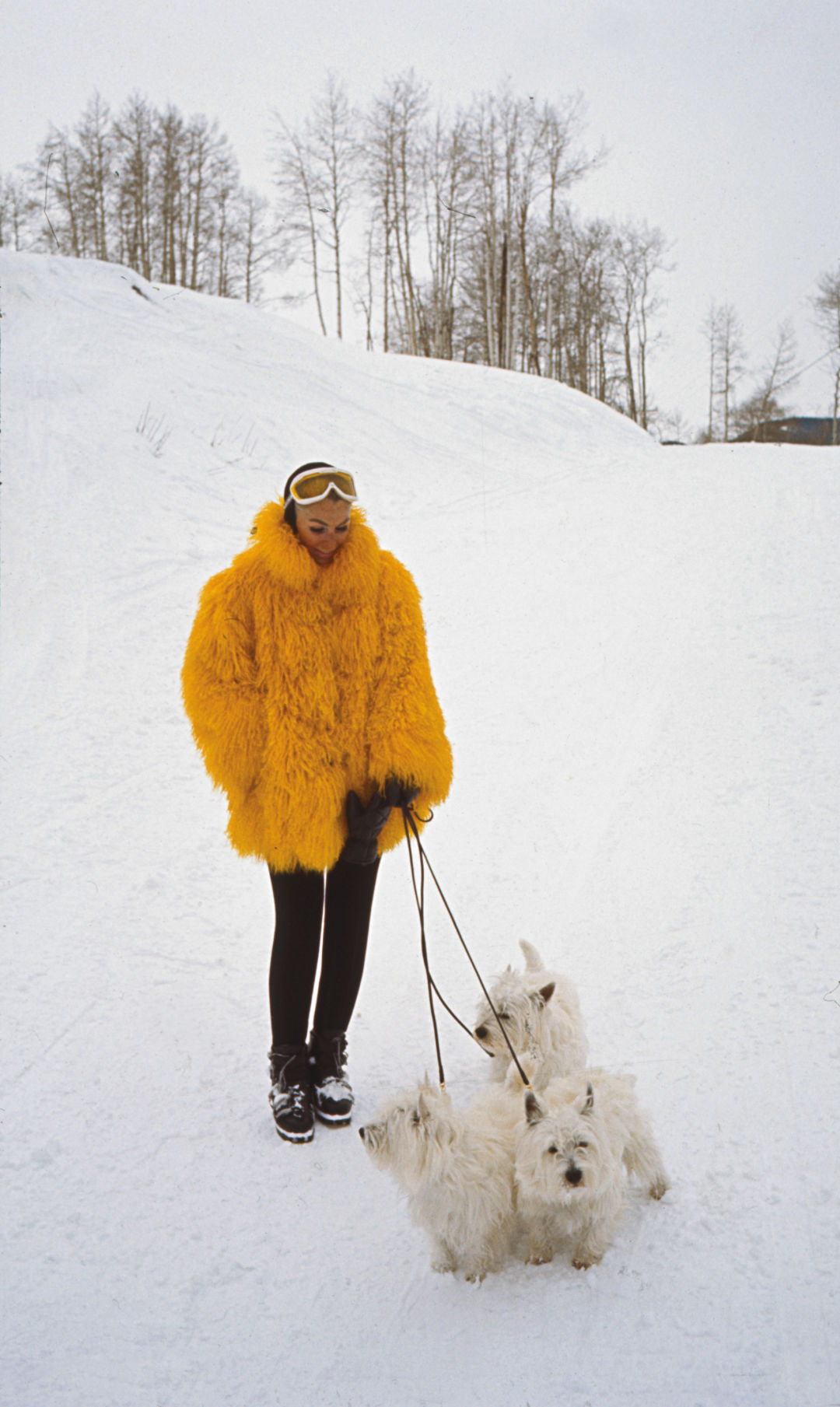
It’s all she has left of the woman who forever changed her life: a great cloak of Mongolian sheep’s wool with the loft and color of Big Bird. Asked about the first time she ever saw that electric yellow coat, Sheika Gramshammer settles into a couch in the foyer of the landmark Vail Village gasthof that bears her name and has been her home since 1964. Then she drifts back to a wintry evening fifty Januarys ago, the night she met Ann Taylor. "She was the grande dame of Vail,” Gramshammer sighs.
You can see the change in her eyes: the decades and triumphs and tragedies all melding together and melting away, and suddenly this septuagenarian who might be anybody’s doting grandmother is 24 again, young and wide-eyed. Her name is Sheika Moser, an Austrian-born fashion model and Las Vegas showgirl whose itinerant bohemian life has taken an abrupt detour to the Vail Valley, where she’s fallen head-over-high-heels in love with a handsome, athletic Austrian ski racer, a daredevil named Pepi Gramshammer. On this mid-January night, Pepi has taken Sheika on arm to a dinner party at the winter home of Vernon Taylor, the scion of a Texas oil and gas fortune and prominent early investor in Vail who, guided by his wife’s hand, has just completed one of the resort’s first and finest homes: a multimillion-dollar reproduction of a French country manor on Rockledge Road, a freshly paved boulevard of dreams meandering through the snowy wilderness high above the nascent town. On this night, and for decades to come, the Taylor home forms the gravitational center of Vail’s social universe, around which everything and everyone of any consequence orbits.
A servant opens the front door, ushers the couple inside, collects their coats, and escorts them down what Gramshammer describes as “le grand entrance”: a long central corridor with a red carpet and polished European hardwood floors reflecting a coved backlit ceiling, less like the entrance hall of the typical American home and more like the exhibition hall of a museum. In a way, that’s exactly what it is: on hook after filigreed hook hang dozens of furs and capes and cloaks and wraps belonging not to the formally dressed guests mixing and mingling over cocktails in the home’s inner sanctum, but to the hostess, a designer and collector of avant-garde skiwear whose eccentric and eclectic tastes have warranted cover stories and extended features in Life, Vogue, Town & Country, and Harper’s Bazaar. Like Edmund and Lucy from The Lion, the Witch and the Wardrobe, Pepi and Sheika stroll hand in hand through a forest of furs, crossing into another world. It may not have been Narnia, but to an impressionable young woman enamored with the fashions of New York, the Taylor home was a realm every bit as magical.
“The hallway was just her furs; they were decorating items,” Gramshammer recalls. “And I go, ‘Wow! Look at these coats, Pepi!’ One was bright red, the other one was yellow—the curly Mongolian sheep—the other one was black, then she had a cape hanging there. It was like a showcase, just like pieces of art the way she displayed them. It was beautiful.”
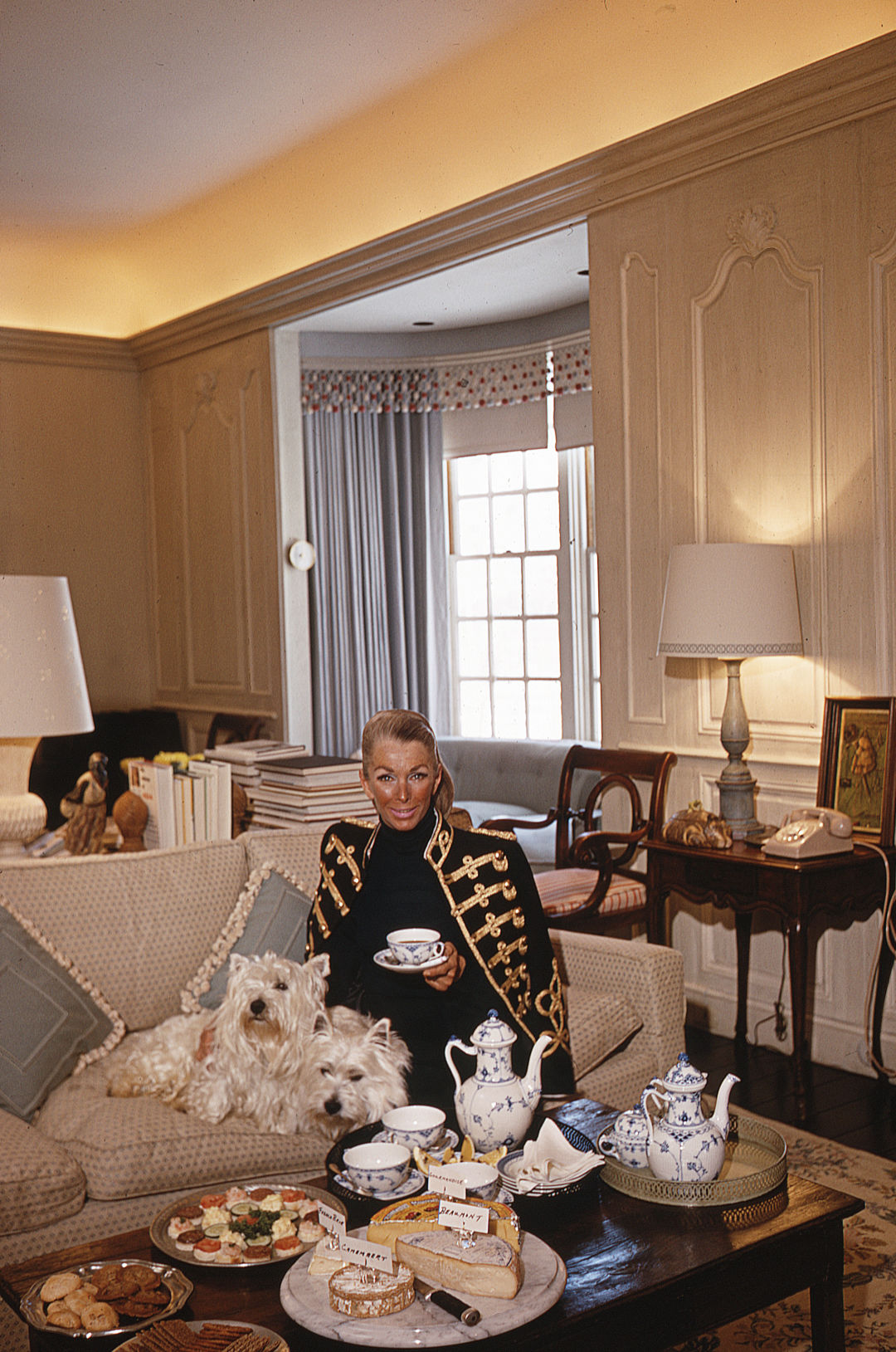
Fresh off the slopes, still wearing lace-up ski boots, Ann Taylor relaxes in her parlor with a cup of tea.
Exiting the entrance hall, they descend three rounded steps into a sunken parlor with walls of lacquered, powder blue eighteenth-century French paneling. The room is alive with laughter and conversation, with guests lounging on plush sofas and armchairs clustered around a blazing hearth and reclining on cushioned benches inset into French bay windows overlooking the lights of the village below. Like ice dancers on a frozen pond, guests with drinks in hand are gliding over an expanse of luxurious orange and white and blue antique needlepoint carpeting, fetching flutes of champagne from silver trays borne by service staff in starched gray uniforms and white aprons. In the center of it all stands Vernon Taylor, in a conservative smoking jacket, a bear of a man with a booming laugh so much larger than life that his friends called him “Moose.” And nearby stands his bejeweled wife, a silhouette of femininity wearing ... Gramshammer can’t recall precisely what, but perhaps a knee-length aquamarine Hubert de Givenchy cocktail dress, with large golden cuff bracelets and earrings, lips and nails painted pink (never red, which is gauche) and hair of spun gold pulled back in a bun, every strand perfectly coiffed. Cigarette in hand, she stops midconversation to study this interesting newcomer whom she did not invite, the tall brunette with the poise and confidence of a model in a revealing bright-pink Emilio Pucci blouse and tight lime-green pants inherited from a fashion shoot.
“She was standing there talking to people, and when she saw Pepi she came to talk to him because she knew him. When Pepi introduced me she looked me over, from toe up, and she knows that I wear designer outfit and she looked at me and I said, ‘Hello, nice meeting you, I am Sheika!’”
Then, adopting a move from Marilyn Monroe, the young Sheika does something characteristically brash: she pirouettes for her inquisitor and asks coyly, “Do you like?”
For a pregnant moment, all eyes are on the interloper.
“And she broke out laughing and from that moment, we became good friends,” Gramshammer says, smiling, then abruptly, as though a cloud had veiled the sun, turning serious. On December 3, 2012, Ann Taylor would have been 102 years old.
As for the type of woman she was, perhaps the most poignant reckoning can be found in the forty-two pages of Cleared for Take-Off, an autobiography that friends published in 1999, of which only four copies remain. Her story begins in 1910 on the banks of the Mississippi in Quincy, Illinois, where Ann Bonfoey was born into a family that “owned quite a bit of property.” These holdings included a pharmaceutical and dye manufacturing company, which her grandfather had founded, and an airfield, a grass strip her doting father and uncle had carved out of a cornfield.
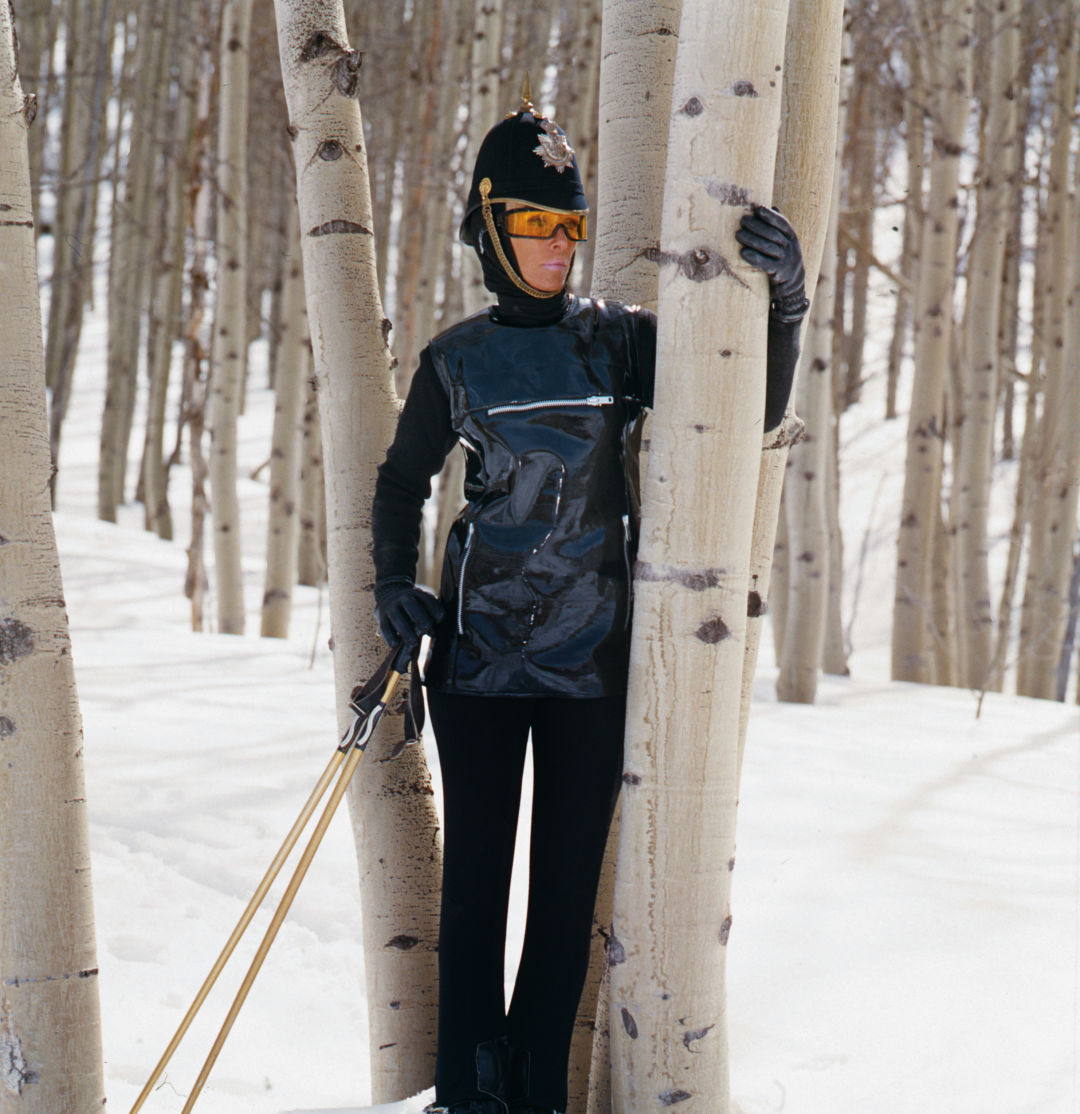
Photographer Toni Frissell shot these 1960s-era images of Ann Taylor vamping on the slopes of Vail.
“I was quite a spoiled puppy growing up with my three brothers, and I was given everything a little girl could possibly want,” Taylor writes. “What made my upbringing more interesting, however, was that ... we had our own little airport which was quite exciting. At that point my father also bought his own plane and he hired a pilot to fly for us.”
When she was 12, Lawrence Bonfoey paid a flight instructor to give his daughter lessons because, as she explains it, she had flowered into a beauty and her father had “found it difficult to cope, especially when boys started coming round to the house to see me, so I’m sure he thought flying would be a useful distraction.”
It was, at least initially. While potential suitors went joyriding in Model Ts, Ann Bonfoey delighted in piloting her father’s handmade Bellanca through the skies above Quincy. After graduating from a prestigious boarding school in upstate New York, where she embraced athletics and excelled in everything from tennis to dressage, Ann Bonfoey married a Princeton undergraduate named James Cooke in 1928, when she was 18. She describes him as “a man whom I found quite uninteresting,” noting that her father “encouraged the match because he didn’t think my local beaux were ‘quality’ enough for me.”
Dutifully, she gave birth to her first child that year, and another two years later, and the young couple settled in Vermont. While her husband managed one of his family’s factories in Burlington, she split her time between mothering, modeling in New York City (posing for magazine advertisements, including for Lucky Strike cigarettes), and sports (nationally ranked in tennis, she played at Wimbledon). To escape an increasingly troubled marriage, in the wintertime she taught herself to ski and found solace competing on the slopes of nearby Mount Mansfield, where she quickly mastered its most difficult run—so steep, it was named Nose Dive—and in 1939 earned a berth as an alternate on the US Ski Team.
Her exploits, coupled with her beauty and unique fashion sense, began to attract national attention. Harper’s Bazaar published a full-page black-and-white photo shot at Stowe, with the vivacious young mother jauntily shouldering a pair of wooden skis with bear-trap bindings, wearing a plastic visor over her head, a radiant smile on her face, and one of her signature fluffy Mongolian wool coats on her back, noting: “Mrs. James Negley Cooke, Jr., has become so closely identified with Mt. Mansfield’s crack ski trail that everyone calls her ‘Nose Dive Annie.’ She practically lives on it, and is so expert on its dizzy twists and schusses that when she enters a Nose Dive race the other entries blanch.
Then her life unraveled, first with the cancellation of the 1940 Olympic Winter Games due to the onset of war in Europe, then with the dissolution of her marriage (after her husband ran off with a dear friend, another member of the women’s ski team). Having been born into wealth, she found herself utterly alone, with two children and, for the first time in her life, without money.
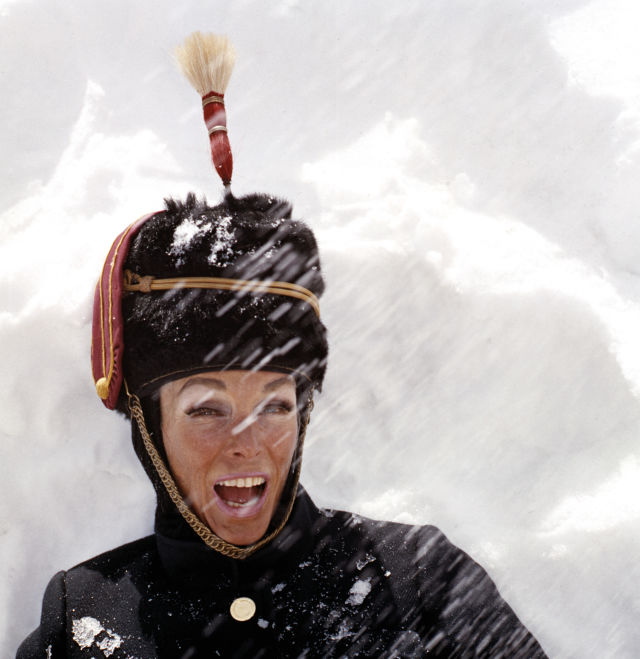
Photographer Toni Frissell shot these 1960s-era images of Ann Taylor vamping on the slopes of Vail.
“I then had to decide what on earth I was going to do with my life,” Taylor writes. “My ex-husband had no intention of taking care of me properly, despite the terms of our divorce settlement. Nor was my family able to help: my father, who was a brilliant but self-destructive man, had been addicted to prescription drugs. Meanwhile, my grandfather had slowly become senile and allowed his fortune to slip through his fingers...The only thing I knew a little bit about was aviation. I knew I liked planes.”
And so in March 1941, she sold a piece of jewelry her parents had given her on her 18th birthday and enrolled as an aviation major at the University of Vermont. She would quickly earn her wings as a commercial flight instructor (becoming one of just twenty-five women so qualified in the country), and she soon became one of a handful of women enlisted by the US Army to train Air Corps cadets. She spent the war years commuting (and sometimes hitchhiking) between a rented barn in Stowe (where a maid watched over her children) and the airport in Burlington six days a week, earning another full-page photo in Harper’s Bazaar in February 1943 as a “flying schoolmarm” posed next to her open-cockpit army trainer, gazing skyward wearing wool ski trousers and a parachute over a fur-lined parka. The caption notes: “The men have taken kindly to their dazzling teacher. When occasionally she gets an overly cocky student, she gives him a dose of air acrobatics—tortures which she itemizes casually as wringing out, spins, snap rolls, and chandelles.”
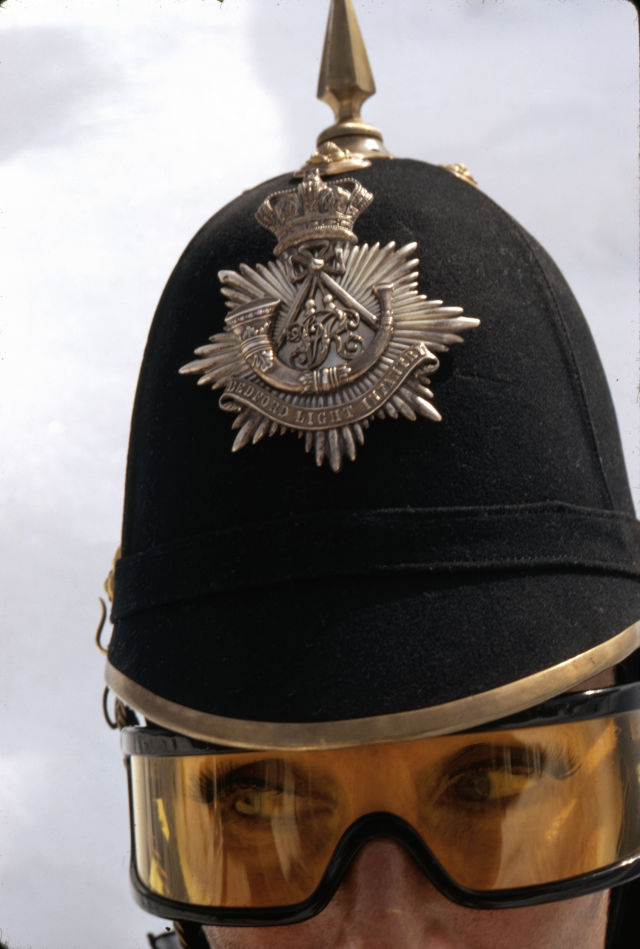
Photographer Toni Frissell shot these 1960s-era images of Ann Taylor vamping on the slopes of Vail.
Some took to their instructor too kindly. In her memoir, she writes that one of her students, a Vanderbilt, invited her to the family estate, where after “a delicious dinner in a beautiful 18th century wood-paneled dining room,” he made a very unwelcome and extremely unwise sexual advance: “‘Harry, you’re foolish, how ridiculous!’ I told him and we got into the most tremendous fight, overturning lamps and furniture. Harry was a very slight man while I was very strong for a woman and fortunately I was also dressed in blue jeans and tennis sneakers. I battled away and managed to escape, telling Harry he’d been a damned fool.”
After the war ended in 1945, out of her barn in Stowe she launched her own clothing label—Ann Cooke—using her name and growing fame to market a line of distinctive homemade skiwear and innovations she had honed on the slopes of Mount Mansfield, including the first fanny pack. She bundled her knit ski sweaters and wool trousers in boxes, took a train to New York City, and talked her way into an audience with the editor of Harper’s Bazaar.
“‘I want the clothes photographed in the snow by the best photographers in New York, plus unlimited money,’ I told her,” Taylor recalls. She was astonished at the reply: “Granted, granted.”
After a six-page fashion spread—shot on the flanks of New Hampshire’s Mount Washington—ran in Harper’s Bazaar in January 1946 (the designer herself made the cover, modeling a gray-and-gold Forstmann wool sweater—the yarn was sourced from Vermont and dyed on stovetops in local kitchens—and mirrored goggles with a leather military utility belt), the entrepreneur was inundated with so many orders that she was unable to keep up with demand. She sold distribution rights to Lord & Taylor, which featured her clothing in window displays on Fifth Avenue in New York City and in twenty other stores, employing 300 inmates from the women’s penitentiary to knit around the clock.
That winter, she met the love of her life, Vernon “Moose” Taylor Jr., when the handsome young Texas oilman, who resembled Gregory Peck and was bound for Quebec’s Mont-Tremblant, called on her shop in Stowe to purchase a pair of ski trousers. “I thought he was delicious,” Ann Taylor explains in Cleared for Take-Off. Enlisting the help of two friends, she surreptitiously followed him to Canada.
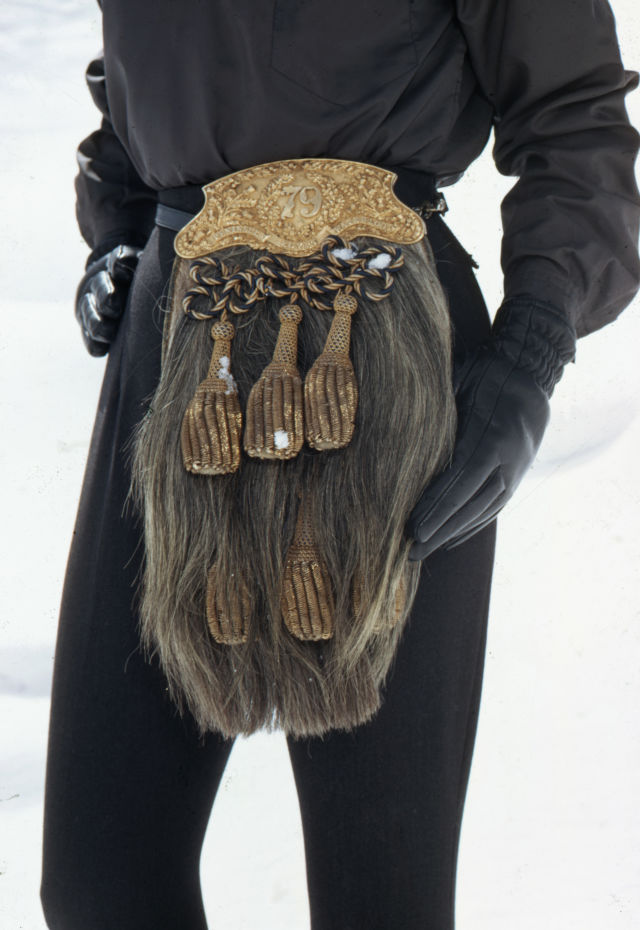
Photographer Toni Frissell shot these 1960s-era images of Ann Taylor vamping on the slopes of Vail.
“Of course, I feigned great surprise when we bumped into each other,” Taylor writes. “‘Those ski clothes of yours,’ said Moose. ‘I had to leave the restaurant after breakfast this morning with the New York Times in front of me because the zipper went on the trousers. They’re the most appalling clothes I’ve ever bought in my life!’ ‘Oh, Mr. Taylor, I do owe you an apology,’ I replied. ‘Will you have tea or a drink with me at five o’clock?’...In the end he just said: ‘I think I’d like to have a ski house and we could get married.’
By May, they were.
But her fame and financial independence were decidedly at odds with Moose Taylor’s notion of the role of the Texas housewife. While staying at the St. Regis and zipping about Manhattan with her own limo and driver that Christmas (she had been contracted to produce clothes for Lord & Taylor’s Christmas windows and costumes for the Rockettes’ Radio City Music Hall holiday pageant), she received an ultimatum, via telegram, from San Antonio: “Take off the golden slippers, woman. Come home to hard reality.”
She did exactly that. Exiling herself to Texas, Ann Cooke abandoned the fashion world—and flying—and adopted a new life as Ann Taylor. (Coincidentally in 1954, Richard Liebeskind would choose the name Ann Taylor—as he explained it, “Ann” sounded New England-y and “Taylor” called to mind well-tailored clothing—for a New Haven boutique that would evolve into a retail chain valued at more than $2 billion.)
“I had already decided that my talent as a designer had its limits,” she writes in the conclusion of her autobiography. “I plucked my courage and asked the top people in New York exactly how long they thought I could last. ‘Five years,’ they said, but I figured it would probably be more like three. ... I couldn’t see that all that would bring me a great deal of happiness.”
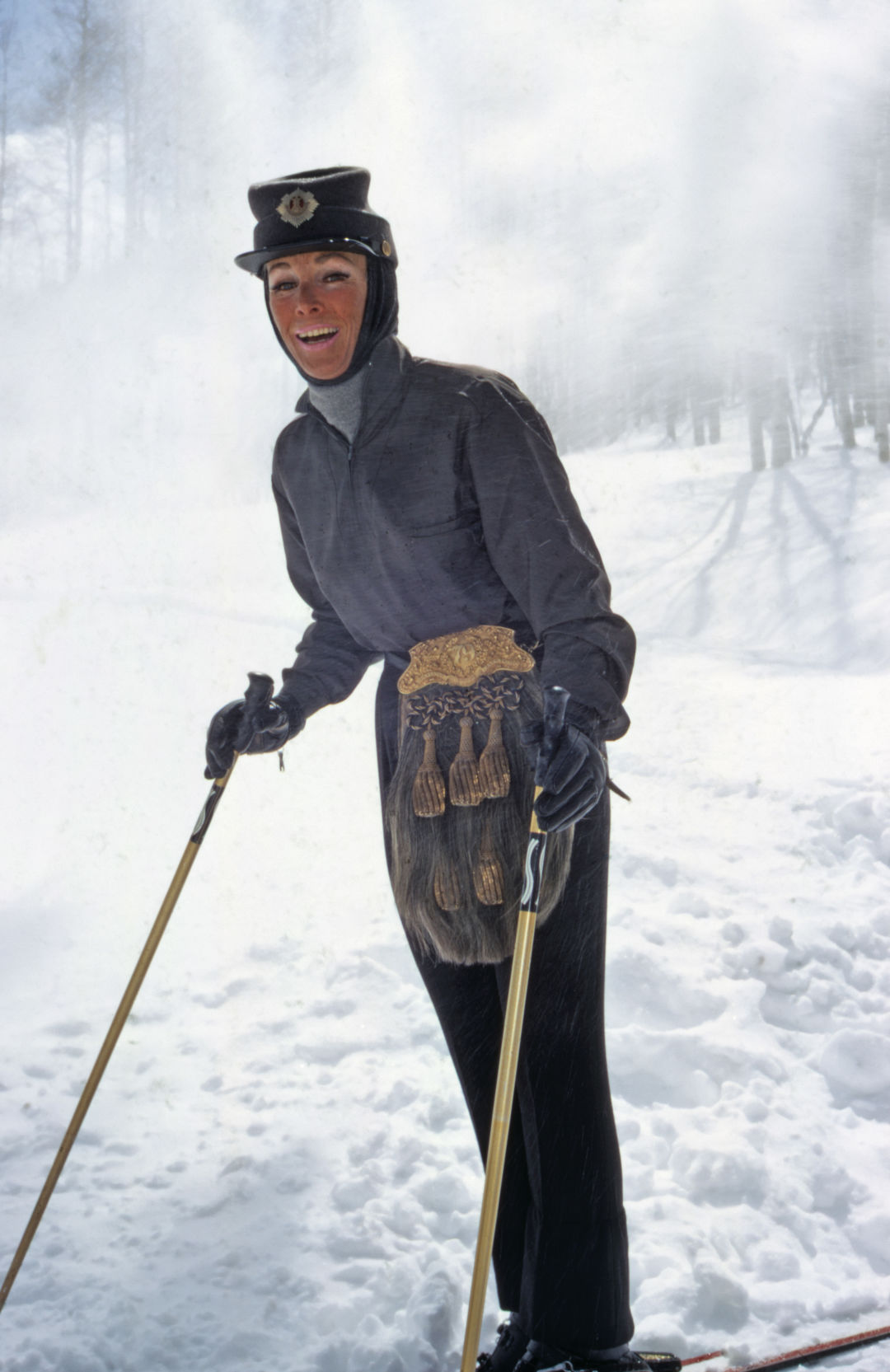
Photographer Toni Frissell shot these 1960s-era images of Ann Taylor vamping on the slopes of Vail.
But being the wife of Vernon Taylor Jr. did. As she puts it: “I went on to lead a fascinating life with Moose, traveling all over the world and meeting dozens of remarkable personalities.” Including British nobility. By all accounts, Vernon Taylor spared no expense on his unconventional bride, treating her as though she were a princess. To be closer to the mountains she adored, in 1951 they relocated to Denver, to a sprawling English manor on 160 acres, complete with stables and horses and hounds for fox hunts. And inside were closets upon closets devoted to assorted types of attire. No longer a designer of clothes, Ann Taylor became a collector, ultimately amassing 4,500 pieces via calls on the world’s greatest fashion houses—gowns and dresses and frocks from Cristóbal Balenciaga, Mariano Fortuny, James Galanos, Madame Grès, Hubert de Givenchy, and Charles James. (Moose gifted the collection to the Phoenix Art Museum in 2008, and it was exhibited in a 2011 show, Fashion Independent: The Original Style of Ann Bonfoey Taylor.) She had dozens of pairs of English riding boots and helmets matching formal and informal jackets; capes and skirts and trousers and boots for shooting (and a matched pair of 20-gauge shotguns); and an even more elaborate set of costumes for skiing, which she accessorized with military hats and belts and any other cultural or regional accoutrement that caught her fancy.
And in 1963, Moose completed that ensemble with the ski house in the mountains that he had promised during their brief courtship.
Vernon Taylor built his wife a ski chalet on the choicest quadruple lot in Vail, at the foot of Bear Tree run, where they would winter for more than forty years. She employed a ski instructor—neighbor Ulf Edborg—and skied most mornings and afternoons in the old-school European style, feet clamped together, carving turns in slow but graceful arcs. And she turned heads not just because of her looks, but because of what she wore, donning the yellow Big Bird coat paired with, say, wool stockings with racing stripes beneath a pink tutu, accessorized with a sporran (the horsehair purse Scotsmen wear with kilts) and a British hussar’s plumed busby helmet that had been worn at the Battle of Balaclava.
Real estate agent Bob Dorf remembers the day he first met Ann Taylor as a ski instructor in the 1960s, when he was asked to fill in for Edborg at Mid Vail.
“She was dressed as a soldier, in some sort of black-and-red uniform,” he recalls. “I didn’t give it a second thought. She was delightful, such a classy lady.”
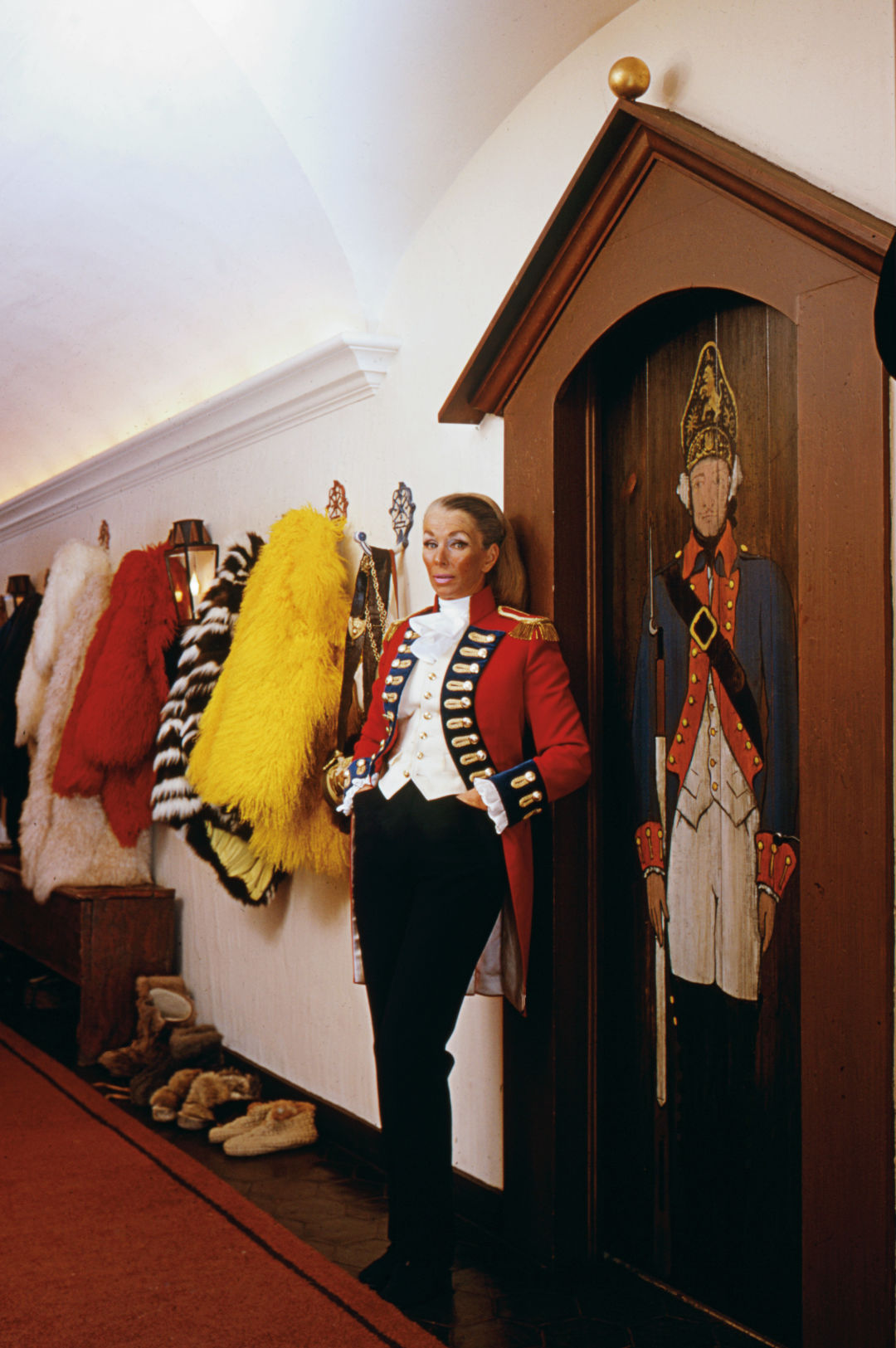
She used her iconic style, and her connections in New York (she was great friends with socialite Nan Kempner), to put Vail on the map, leveraging her influence with fashion editors like Vogue’s Diana Vreeland and celebrity photographers like Toni Frissell to land herself—and Vail—in the national spotlight. In January 1965, Life published a Toni Frissell photo essay celebrating Ann Taylor’s unconventional fashion sense (“An Inventive Skier’s Worldly Wardrobe”), including full-page photographs of the doyenne on the slopes of Vail Mountain wearing the dress uniform of a Greek mountain infantryman and an Arabian ghutra head scarf captioned: “Mrs. Vernon Taylor of Denver is a dedicated skier and world traveler with an eye for improbable but practical ski clothes. She saw this headgear in Saudi Arabia and figured that since it has protected against the blowing sand for centuries it would provide fine protection against wind and blowing snow.”
Other stories followed in quick succession: Harper’s Bazaar named Ann Taylor “One of the 100 Great Beauties of the World” in 1967; Vogue fêted her in a story titled “The Great Ski Life Wit and Dash Added by Mrs. Vernon Taylor, Jr”; Town & Country devoted an entire feature to her headgear alone (“The 101 Hats of Mrs. Vernon Taylor”).
Her notoriety in print helped her lure the right people to town, throwing dinner parties not just for Moose’s business associates (such as IBM CEO T.J. Watson Jr.) but for movie stars (Gregory Peck), authors (Truman Capote) and budding politicians (Gerald Ford and Henry Kissinger). But she always rounded out the guest list and populated her twelve-seat dinner table (equipped with a recessed button to summon servants) with locals, like Patsy Manley Smith and her husband, Bill, who knew Ann Taylor when she was Ann Cooke of Stowe.
“She was always very friendly and would say, ‘Come on over!’” Patsy Manley Smith recalls. “I would be dressed in black pants and a nice top, but she’d be wearing a very dramatic dress. She had such flair, you wouldn’t forget that she was a model. She was the perfect hostess. ... She brought class and a lot of interesting people who invested in Vail.”
Sheika Gramshammer puts it this way: “She brought high society, the blue book from New York and Europe, to Vail, and for them she opened up the mountain and hired instructors to go skiing with them. She really showed off Vail very well. People would go back to Europe, and they’d be talking about the new Vail.”
Whenever guests came to town, she’d phone Bob Dorf at the ski school and sign them up for lessons, charged to her running account. But at the end of the season, when Dorf presented her with a final reckoning, the millionaire would always blanch.
“I’d show her the bill, and she would say, ‘Oh, Bob, that’s much too much,’” Dorf recalls. “I would point to an entry and say, ‘So-and-so skied with me that day,’ and she’d say, ‘Oh, I know they weren’t there that day.’ Then I would tear the thing down to $3,000, and say, ‘Ann, if that’s OK with you, then it’s OK with me.’”
Then Dorf would drive to Denver and submit the original bill to her husband.
“I would be escorted into this absolutely incredible office with wood on the walls from some ancient ship, and Moose would be sitting there—he knew I took meticulous notes—and he would ask, ‘OK, Bob, how much was it this year?’ And I’d say it was $5,200, and he would call his secretary and say, ‘Please write the Vail Ski School a check for $5,200.’ He was such a wonderful man. ... Ann, she was pleasantly forceful, and always got her way. She was almost British in her demeanor, more aloof and erudite.”
Ann Taylor carried herself like royalty because to Vail, that’s precisely what she was. One close friend admits that she was terrified the first time she was introduced to her. Dave Gorsuch, who met the Taylors skiing in Squaw Valley when he and his wife were on the Olympic ski team, says she was often misunderstood. “She ran deeper than a lot of people knew,” he says. “People would dismiss her as some sort of strange person, but she was no fool.”
Perhaps nobody understood Ann Taylor better than Sheika Gramshammer, who, after that party in 1963, visited the Taylor home almost daily and became a confidante. As a token of their friendship, the fashionista gifted her young protégée the yellow Mongolian wool cloak and took to calling her “my yellow bird.”
“She maybe didn’t have the warmth—that’s one thing she was missing,” says Gramshammer. “But behind the doors in private, her husband meant everything to her—more than her kids, more than her friends. That relationship between them was truly love. I think she had no room for anyone else. Sometimes she was like a mother to me, but she was not a motherly figure at all.
“She was always disciplined, always correct, and you had to be correct with her. If you misbehaved at a party, you were never invited anymore. She was unique. I admire her tremendously.”
But not even Sheika Gramshammer was allowed into Ann Taylor’s holiest of holies: her closet.
“I don’t think she wears the same clothes two times,” Gramshammer laughs. “You know what it is, in America only we have home tours looking into people’s closets. In Europe, the closet is your privacy.”
And that one last repository would remain her refuge until the day she died.
Ann Taylor skied and entertained at Vail until her ninth decade, when life—and far too many cigarettes—eventually caught up with her. Regularly struggling to breathe in the high altitude, she emptied her ski chalet in 2005, locked the front door, and never returned to Rockledge Road again.
“When she closed the house, she was very sad,” Gramshammer recalls. “She didn’t want to talk about her house anymore. She loved it.”
Back in Denver, as the weeks turned to months, her health deteriorated. Gradually, the life drained out of her until even the smoldering ember, that spark that had made her special, extinguished. Gramshammer remained at her bedside through it all, and she does not like to talk about those last days.
“At the end, when it was happening, I would walk out of the house and say, ‘Please, God, let her go,’” she recounts, crying, sitting there on the couch, wiping her eyes. “In the prime of her life she was so unique, and then at the end of her life she’s just like all of us, nothing different—so unique, then at the end just like so many millions of people. She wrote her own life story and she lived it, she lived by it. Ja, I miss her. But he’s still around.”
She means Vernon Taylor. Every so often, Sheika Gramshammer drives to Denver, to a stone manor lost in time, to pay a visit. And on the way to his office, she pauses by Ann Taylor’s bedroom, left precisely as it was on November 3, 2007, the day she died.
“Moose, now he is blind, he can’t see much anymore. He is 95, too, and his memory is going, so what do we do? We sit there and we talk about Ann. It’s amazing. Her bedroom in Denver is the same, just as she would have wanted it. Every day they bring fresh flowers, and every time I walk by her bedroom, I go, ‘Is she going to come out of the bedroom?’”
She never does.
But back at Hotel-Gasthof Gramshammer, when Sheika Moser shrugs on the coat of yellow Mongolian wool, spins, and asks, “Do you like?” she still hears Ann Taylor’s angelic laugh.







































